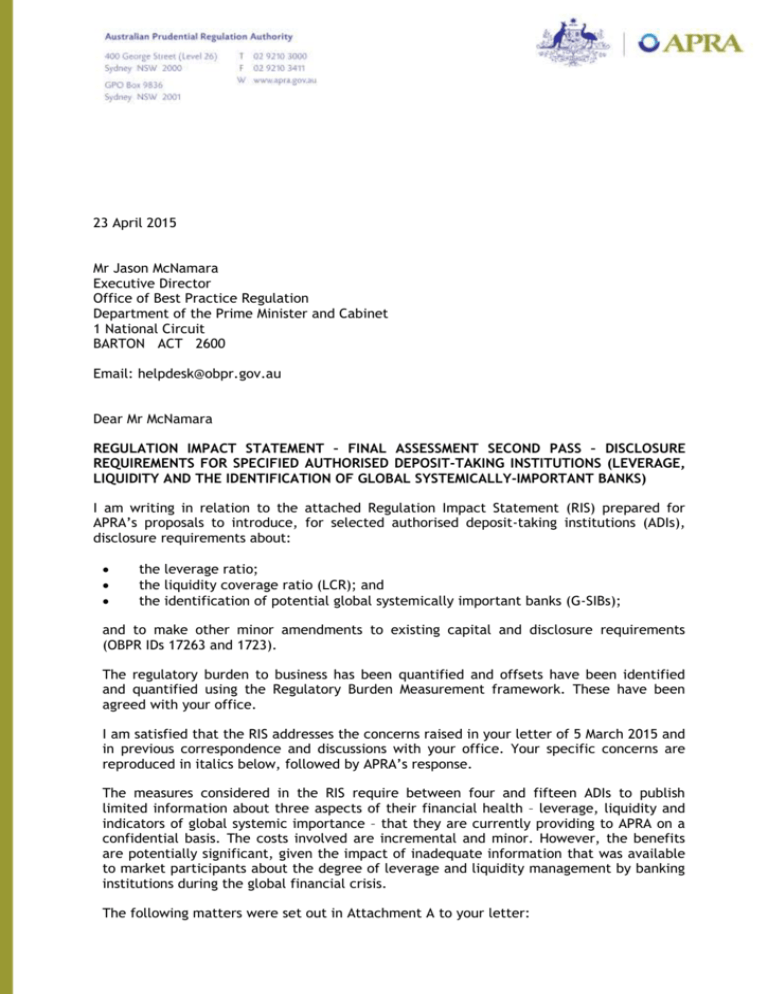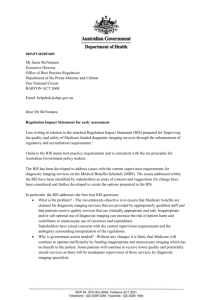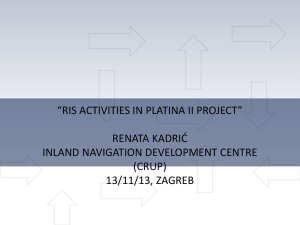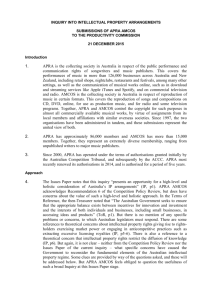Basel III disclosure requirements - Best Practice Regulation Updates
advertisement

Wayne Byres CHAIRMAN 23 April 2015 Mr Jason McNamara Executive Director Office of Best Practice Regulation Department of the Prime Minister and Cabinet 1 National Circuit BARTON ACT 2600 Email: helpdesk@obpr.gov.au Dear Mr McNamara REGULATION IMPACT STATEMENT – FINAL ASSESSMENT SECOND PASS – DISCLOSURE REQUIREMENTS FOR SPECIFIED AUTHORISED DEPOSIT-TAKING INSTITUTIONS (LEVERAGE, LIQUIDITY AND THE IDENTIFICATION OF GLOBAL SYSTEMICALLY-IMPORTANT BANKS) I am writing in relation to the attached Regulation Impact Statement (RIS) prepared for APRA’s proposals to introduce, for selected authorised deposit-taking institutions (ADIs), disclosure requirements about: the leverage ratio; the liquidity coverage ratio (LCR); and the identification of potential global systemically important banks (G-SIBs); and to make other minor amendments to existing capital and disclosure requirements (OBPR IDs 17263 and 1723). The regulatory burden to business has been quantified and offsets have been identified and quantified using the Regulatory Burden Measurement framework. These have been agreed with your office. I am satisfied that the RIS addresses the concerns raised in your letter of 5 March 2015 and in previous correspondence and discussions with your office. Your specific concerns are reproduced in italics below, followed by APRA’s response. The measures considered in the RIS require between four and fifteen ADIs to publish limited information about three aspects of their financial health – leverage, liquidity and indicators of global systemic importance – that they are currently providing to APRA on a confidential basis. The costs involved are incremental and minor. However, the benefits are potentially significant, given the impact of inadequate information that was available to market participants about the degree of leverage and liquidity management by banking institutions during the global financial crisis. The following matters were set out in Attachment A to your letter: 2 1. The RIS contains much information about the GFC, the existing regulatory framework and prior commentary on proposed regulatory changes. While useful, this information could be summarised in a few paragraphs. APRA has summarised the information about the existing regulatory framework. APRA assumes that ‘prior commentary on proposed regulatory changes’ refers to the background information relating to the response of the Basel Committee on Banking Supervision and the Group of 20 (G20) to experiences of the global financial crisis. This information has also been summarised. 2. Consistent with discussions between our offices the RIS should clearly explain the significance of the remaining problem having regard to the substantive Basel III requirements that are already in place. For example, are the information disclosure requirements aimed at enhancing existing measures, or solving a separate problem (such as information asymmetry)? If the former the RIS should clearly outline how the existing measures would be enhanced. If the latter the RIS should give more direct evidence of an information asymmetry, including who is affected by it and what role it played (if any) in the GFC relative to other factors. The disclosure requirements are aimed at enhancing the existing Pillar 3 framework, which is designed to harness market discipline by addressing information asymmetry about particular aspects of banking institutions’ financial health. As outlined in the RIS, the impact of information asymmetry was evidenced during the global financial crisis, where a lack of reliable public information about banks’ liquidity and leverage contributed to the crisis and restrictions in funding and capital, information which is still not readily available in a consistent or comparable way some seven years after the onset of the crisis. The RIS has been amended to indicate the other factors involved in the global crisis and includes additional evidence of information asymmetry and affected parties. As discussed previously with your office, and as outlined in your letter of 28 October 2014 about the ‘early-stage RIS’, another important aspect of the problem is ensuring Australia’s compliance with its G20 and other international commitments. 3. ADIs are currently required to provide APRA with a range of information under existing disclosure requirements. To clarify the discussion about the incremental burden of the proposed disclosure requirements, the RIS should briefly outline the: a. current APRA disclosure requirements relevant to the ADIs affected by the proposal; and b. extent to which the proposed disclosure requirements would be an incremental increase on the existing disclosure requirements. The RIS now provides further information about the requirements that currently apply to affected ADIs and outlines the incremental nature of the proposals when measured against these Pillar 3 requirements. The RIS now also describes how affected ADIs are already providing the relevant data to APRA under an existing data collection process and/or an existing reporting obligation; in effect, the proposed measures require this information to be published in the appropriate format within specified timeframes. 4. The RIS explains that one of the benefits of the proposal is that without APRA intervention, ADIs face potential increases in their cost of capital and reputation to themselves and the Australian financial sector. This discussion indicates that Australian ADIs would have a large financial incentive to ensure that they jointly meet the Basel III disclosure requirements. The RIS should clearly explain whether 3 ADIs would disclose the relevant information under the status quo. The RIS should discuss: a. why, if it is in their best interests, ADIs wouldn’t disclose information voluntarily; and b. whether Australian ADIs would meet the Basel III requirements if APRA did not intervene with the proposed disclosure requirements. The RIS notes that ADIs are not uniformly disclosing the information that will be required under the proposed measures, even though affected ADIs have been compiling and submitting it to APRA. The RIS now also expands the previous reference to the need for international comparability of information and affected ADIs’ preference for regulatory imprimatur for public disclosures of regulatory information in comparable formats. 5. In light of the discussion above, the net benefits of the options should be reframed to reflect the incremental impact of introducing the disclosure requirements above and beyond the status quo. APRA has reframed its analysis to more clearly demonstrate the incremental nature of the proposed measures in comparison with existing Pillar 3 disclosure requirements, taking account of ADIs’ current submission of the data to APRA for data collection and/or prudential reporting purposes. APRA remains of the view that the potential costs of retaining the status quo may be material, albeit unquantifiable, and has therefore not amended its position vis-à-vis this aspect of its analysis. 6. The consultation section mentions that the affected ADIs raised specific queries about a number of details in the proposed disclosure requirements. The RIS should outline whether these concerns were incorporate [sic] into the proposal, and how this affects the net benefits of the preferred option. The RIS now includes more detail about the specific concerns raised in submissions and APRA’s response to them and notes that no in-principle objections were made to the overall proposal to introduce these measures. This includes APRA’s decision to extend the timeframe for publication of the G-SIB indicators, a proposal supported by the affected ADIs. APRA anticipates that this will result in a small reduction in regulatory burden and compliance costs and thus have a positive impact on the assessment of Option 3. However, affected ADIs did not provide sufficient supporting data to enable specific quantification of these savings. APRA therefore assessed the options without factoring in any reduction in the costs as a result of the revised approach. 7. The conclusion will need to be revised to reflect changes to the RIS. It will be very important that any uncertainties in the impact analysis are reflected in the conclusion about the net benefit. For example, if there is limited direct evidence and magnitude of an information asymmetry, this would need to be reflected in uncertainties over the potential benefits of the policies, and therefore the netbenefit of the preferred option, and therefore the conclusion. The RIS has been amended to reflect uncertainties in the potential costs and benefits of each option. 8. The RIS should include the identified regulatory cost offsets and agreed regulatory costs in a Regulatory Burden and Cost Offset Estimate Table. APRA has included the Regulatory burden and cost offset estimate table for this proposal in Attachment B of the RIS. 4 Accordingly, I am satisfied that the RIS meets best practice consistent with the Australian Government Guide to Regulation. I submit the RIS to the Office of Best Practice Regulation for formal final assessment. Yours sincerely,







